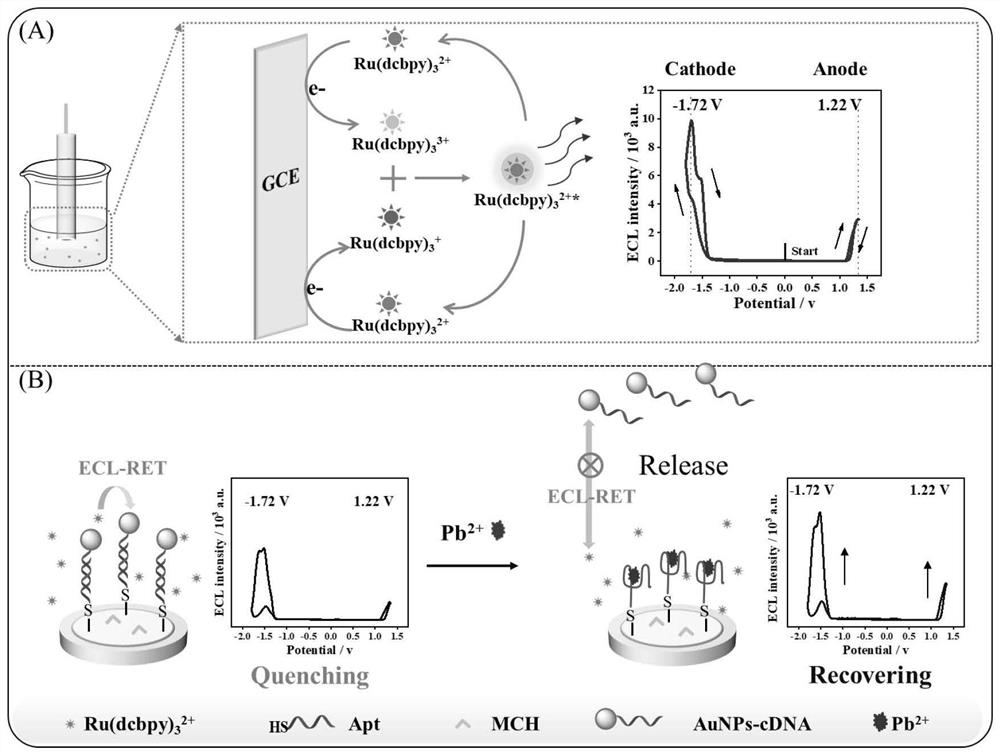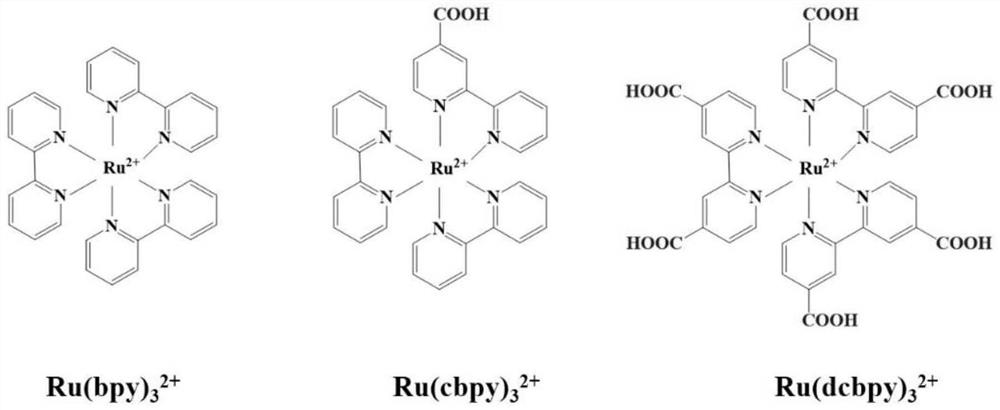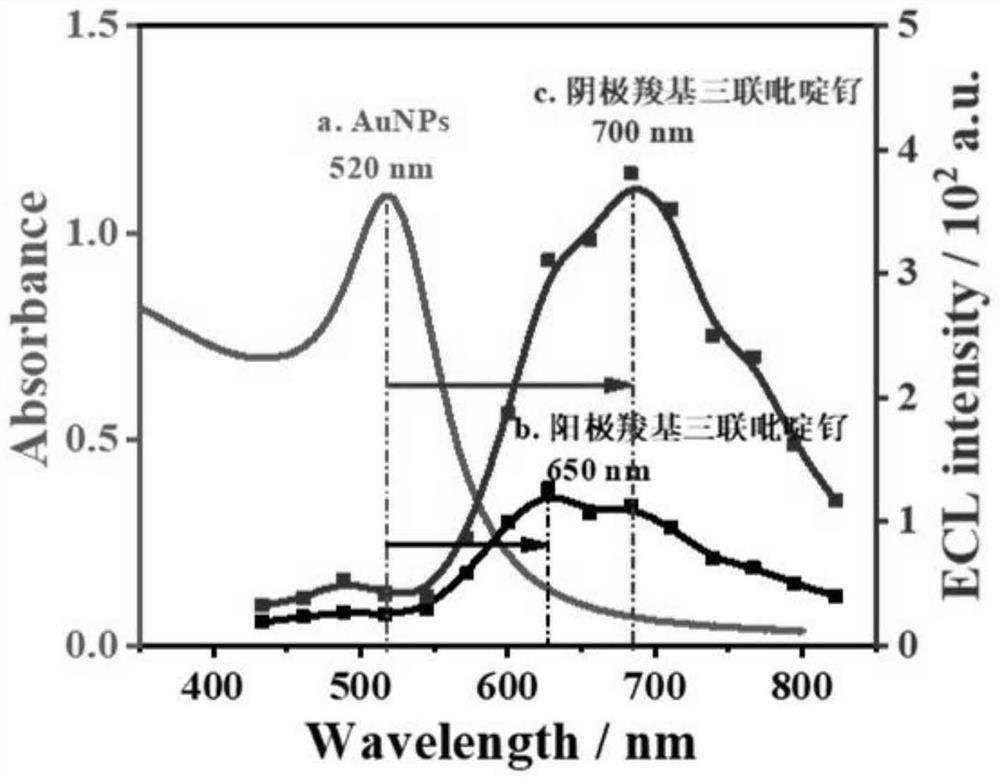Carboxyl ligand induced annihilation type ratio electrochemiluminescence aptamer sensing method for detecting Pb < 2 + >
A sensing method, electrochemical technology, applied in the direction of chemiluminescence/bioluminescence, analysis by making materials undergo chemical reactions, measurement devices, etc., can solve problems that affect the stability of the ECL system, interfere with the detection environment, and measure errors. Achieve excellent stability, improve sensitivity, and improve reliability
- Summary
- Abstract
- Description
- Claims
- Application Information
AI Technical Summary
Problems solved by technology
Method used
Image
Examples
Embodiment 1
[0048] according to figure 1 Described preparation process:
[0049] (1) Preparation of AuNPs and AuNPs-cDNA
[0050] 0.2mL 0.1M HAuCl 4 ·3H 2 O solution was dissolved in 25mL ultrapure water, stirred and dissolved to obtain a mixed solution. Then heat the mixed solution to boiling at 150°C; when the solution boils completely, add 0.25mL of 100mg·mL -1 Sodium citrate solution to obtain a red solution; then, the solution continued to react for 15 minutes and then cooled to room temperature to obtain an AuNPs solution; the obtained AuNPs solution was stored in a refrigerator at 4°C in the dark for later use;
[0051] Preparation of AuNPs-cDNA: First, mix 50 μL of 100 μM cDNA solution with a sulfhydryl group at the end and 100 μL of 10 mM tris(2-carbonylethyl)phosphate hydrochloride (TCEP) solution, and after standing for 1 h, an activated cDNA solution was obtained; then 150 μL of activated cDNA solution and 1850 μL of AuNPs solution were mixed, shaken and incubated for 12 ...
Embodiment 2
[0063] The selectivity of the annihilation-type ratiometric electrochemiluminescence aptasensor was investigated using the sensor prepared in Example 1;
[0064] When placing the ECL aptasensor in aqueous solution, the obtained I 阴 / I 阳 is a blank signal; when different ions (K + , Na + , Ca 2+ ,Mg 2+ , Fe 2+ , Fe 3+ ,Cd 2+ ,Cu 2+ ,Hg 2+ , Ni 2+ ,Mn 2+ ,Zn 2+ , Mix, Pb 2+ and Pb 2+ +Mix) to replace the blank sample, the obtained I 阴 / I 阳 is the test signal; using the absolute value of the difference between the test signal and the blank signal, it is recorded as |ΔI 阴 / I 阳 |, to examine its selection performance.
[0065] Figure 5 is the selectivity of the sensor: where blank refers to an aqueous solution, defined as a blank sample; K + , Na + , Ca 2+ ,Mg 2+ , Fe 2+ , Fe 3+ ,Cd 2+ ,Cu 2+ ,Hg 2+ , Ni 2+ ,Mn 2+ ,Zn 2+ , Mix is used as an interference substance, and Mix is a mixed solution of the above-mentioned 12 kinds of interference ions. ...
Embodiment 3
[0067] Using the sensor prepared in Example 1 to investigate the reproducibility of the annihilation-type ratiometric electrochemiluminescence aptasensor;
[0068] Five ECL aptasensors prepared in parallel in the same batch were respectively placed in a 1.0×10 -9 5 Pb of M 2 + When in solution, record the I within the batch 阴 / I 阳 ; 5 ECL aptasensors prepared in different batches were placed in a 1.0×10 -9 5 Pb of M 2+ When in solution, record the batch-to-batch I 阴 / I 阳 .
[0069] from Image 6 , it can be seen that the relative standard deviation (RSD) of the ECL signals of the five parallel aptasensors within a batch was 2.86%, and 2.62% between batches, proving that the sensor has good reproducibility.
PUM
| Property | Measurement | Unit |
|---|---|---|
| Diameter | aaaaa | aaaaa |
| Concentration | aaaaa | aaaaa |
| Concentration | aaaaa | aaaaa |
Abstract
Description
Claims
Application Information
 Login to View More
Login to View More - R&D
- Intellectual Property
- Life Sciences
- Materials
- Tech Scout
- Unparalleled Data Quality
- Higher Quality Content
- 60% Fewer Hallucinations
Browse by: Latest US Patents, China's latest patents, Technical Efficacy Thesaurus, Application Domain, Technology Topic, Popular Technical Reports.
© 2025 PatSnap. All rights reserved.Legal|Privacy policy|Modern Slavery Act Transparency Statement|Sitemap|About US| Contact US: help@patsnap.com



